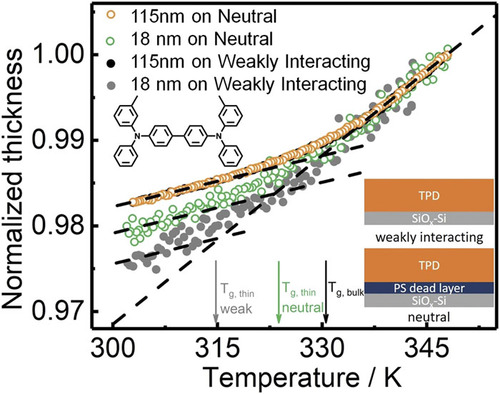Abstract
Interfacial interactions can play an important role in the glass transition temperature (\(T_g\)) and relaxation dynamics of ultra-thin glass polymer films. We have recently shown that similar to the polymeric systems in ultra-thin molecular glass films of \(N, N'\)-Bis(3-methylphenyl)-\(N, N'\) -diphenylbenzidine (TPD), the \(T_g\) is reduced and dynamics are enhanced. Furthermore, in molecular glass systems, as the film thickness is reduced below \(\sim\) 30 nm, the dynamics at the two interfaces correlate such that the range of the gradients in the dynamics induced by the free surface narrows compared to thicker films. These observations indicate that the dynamics of the glassy thin films are strongly correlated and cannot be explained by a simple two-layer model consisting of a bulk and a thin interfacial layer with a constant thickness and constant range of dynamical gradients. Here, we investigate the effect of film/substrate interactions on the film dynamics by varying the TPD/substrate interfacial interactions. We show that thin TPD films with thicknesses below \(\sim\)60 nm show a smaller extent of \(T_g\) reduction and enhanced dynamics when supported on a near-neutral substrate (wetting) compared to a weakly interacting (dewetting) substrate. However, the \(\sim\)30 nm length scale, where the activation energy significantly reduces from its bulk value as measured by the onset of the glass transition remains unchanged. Coarse-grained molecular dynamics simulation also shows a narrowing in the range of relaxation times once the thickness is sufficiently reduced for the two interfaces to dynamically correlate, consistent with previous work. These results suggest that the length-scale for the correlated dynamics is independent of interfacial interactions and the polymeric nature of the film and may originate from the bulk glass properties.
